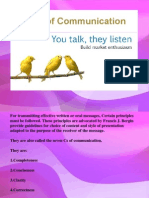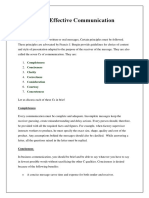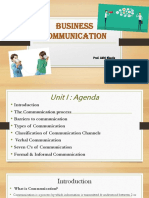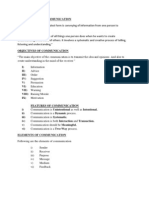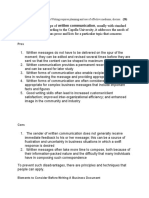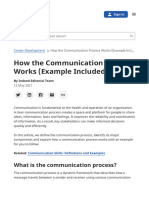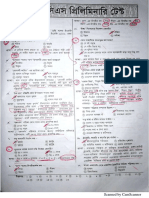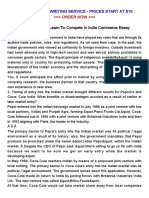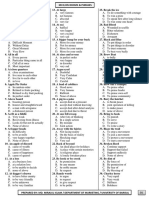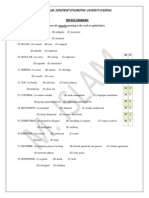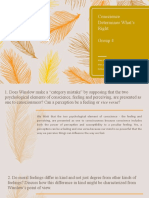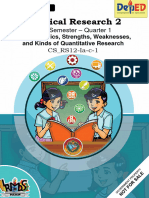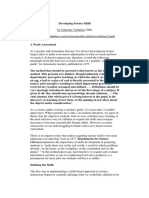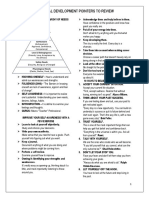Business Communication 1
Business Communication 1
Uploaded by
MirajulIslamCopyright:
Available Formats
Business Communication 1
Business Communication 1
Uploaded by
MirajulIslamOriginal Description:
Copyright
Available Formats
Share this document
Did you find this document useful?
Is this content inappropriate?
Copyright:
Available Formats
Business Communication 1
Business Communication 1
Uploaded by
MirajulIslamCopyright:
Available Formats
1
Reading Material for Business Communication
• Communication Process
• Organizational Communication
• Basic Writing Principles / 7 Cs
• Business / Bad News Letters
• CV and Cover Letter
Communication Process
Following components are involve in communication process
1. Context
2. Sender (Encoder)
3. Message
4. Medium
5. Receiver (Decoder)
6. Feedback
Context
Every message whether oral or written begins with context. It is a broader term which includes
country culture, organization, internal and external stimuli. Context prompts you for sending /
receiving messages and helps you in designing a successful message. Your education, past
experience, liking, disliking, job status, age and confidence influence the way you communicate
with others. For effective communication, your ability to translate the context of your receiver
is as important as is yours. Receiver context includes his culture, expectations, values, opinions,
mental ability, needs, skills, etc.
Sender (Encoder)
As a sender (encoder) you use symbols that express you message and create the desired
response.
www.bankingnewsbd.com, Email: bankingnewsbd@gmail.com
2
Message
You must first decide what the main point of your message is and what other information to be
included. It consists of both verbal (spoken and written) and non-verbal symbols
Medium
Your medium depends upon all the contextual factors (already discussed), and the nature of the
message. The choice of the medium depends upon the relationship between the sender and
receiver 1- Inside your organization (Memo, Reports, Meetings etc.)
2- Outside your organization (Letters, Proposals, faxes, ads, discussions, interviews etc.)
Receiver (Decoder)
The message receiver is your reader or listener also known as decoder, as s/he decodes your
encoded message. Receiver is influenced by his context and by his mental filter.
Feedback
Feedback can be a desire action, an oral or written message, or simply a silence. It is the most
important part of communication process.
Organizational Communication
Organizational Communication
1. Downward communication
2. Upward communication
3. Horizontal communication
4. Informal Communication Channels
Downward Communication
1. Implementation of goals, strategies, and objectives
2. Job instructions and rationale
3. Procedures and practices
4. Performance feedback
5. Indoctrination
www.bankingnewsbd.com, Email: bankingnewsbd@gmail.com
3
Upward Communication
1. Problems and exceptions
2. Suggestions for improvement
3. Performance reports
4. Grievances and disputes
5. Financial and accounting information
Message:
You must first decide what the main point of your message is and what other information to be
included. It consists of both verbal (spoken and written) and non-verbal symbols
Medium:
Your medium depends upon all the contextual factors (already discussed), and the nature of the
message. The choice of the medium depends upon the relationship between the sender and
receiver
1- Inside your organization (Memo, Reports, Meetings etc.)
2- Outside your organization (Letters, Proposals, faxes, ads, discussions, interviews etc.)
Receiver (Decoder):
The message receiver is your reader or listener also known as decoder, as s/he decodes your
encoded message. Receiver is influenced by his context and by his mental filter.
Feedback:
Feedback can be a desire action, an oral or written message, or simply a silence. It is the most
important part of communication process.
Basic Writing / 7Cs
Organizational Communication:
For transmitting effective written or oral messages, Certain principles must be followed. These
principles are advocated by Francis J. Bergin provide guidelines for choice of content and style
of presentation adapted to the purpose of the receiver of the message.
They are also called the seven Cs of communication.
www.bankingnewsbd.com, Email: bankingnewsbd@gmail.com
4
1. Completeness
2. Conciseness
3. Clarity
4. Correctness
5. Consideration
6. Courtesy
7. Concreteness
Completeness
Every communication must be complete and adequate.Incomplete messages keep the receiver
guessing, create misunderstanding and delay actions. Every person should, therefore, be
provided with all the required facts and figures.
For example, when factory supervisor instructs workers to produce, he must specify the exact
size, shape, quality and cost of the product. Any assumptions behind the messages should also
be clarified. While answering a letter, all the questions raised in the letter must be replied.
Conciseness
In business communication, you should be brief and be able to say whatever you have to say in
fewest possible words without sacrificing the other C qualities.
Conciseness is desired because of the following benefits:
1. A concise message saves time and expense for both sender and receiver.
2. Conciseness contributes to emphasis; by eliminating unnecessary words, you let important
ideas stand out.
3. When combined with a (you-view), concise messages are inherently more interesting to
recipients as they avoid unnecessary information.
Clarity
1. Clarity means getting your message across so the receiver will understand what you are
trying to convey.
2. You want that person to interpret your words with the same meaning you have in mind.
3. Accomplishing that goal is difficult because, as you know, individual experiences are never
identical, and words have different meanings to different persons.
Here are some specific ways to help make your messages clear:
1. Choose short, familiar, conversational words.
www.bankingnewsbd.com, Email: bankingnewsbd@gmail.com
5
2. Construct effective sentences and paragraphs.
3. Achieve appropriate readability (and listening ability).
4. Include examples, illustrations, and other visual aids, when desirable.
Correctness
1. The term correctness as applied to business messages means right level of language and
accuracy of facts, figures and words.
2. If the information is not correctly conveyed, the sender will lose credibility.
3. Transmission of incorrect information to superiors will vitiate decision making process.
4. Transmission of incorrect information to outsiders will spoil the public image of the firm.
5. To convey correct messages, grammatical errors should also be avoided.
6. You should not transmit any message unless you are absolutely sure of its correctness.
Consideration
1. Consideration means that you prepare every message with the recipient in mind and try to
put yourself in his or her place.
2. Try to visualize your readers (or listeners)—with their desires, problems, circumstances,
emotions, and probable reactions to your request.
3. Then handle the matter from their point of view
4. This thoughtful consideration is also called you-attitude, empathy, the human touch, and
understanding of human nature. (It does not mean, however, that you should overlook the
needs of your organization.)
Courtesy
Courteous messages help to strengthen present business friendships, as well as make new
friends.
> Courtesy stems from sincere you-attitude.
> It is not merely politeness with mechanical insertions of please's and thank-you'd.
To be courteous, considerate communicators should follow these suggestions regarding tone of
the communications.
> Be sincerely tactful, thoughtful, and appreciative.
> Omit expressions that irritate, hurt, or belittle.
> Grant and apologize good-naturedly.
www.bankingnewsbd.com, Email: bankingnewsbd@gmail.com
6
Concreteness
* Communicating concretely means being specific, definite, and vivid rather than vague and
general.
* The following guidelines should help you compose concrete, convincing messages:
* Use specific facts and figures.
* Put action in your verbs.
* Choose vivid, image-building words.
Business / Bad News Letter
Business Correspondence
1. Business Letter
2. Bad News Letters
Business Letter
• Letter Head
• Date
• Receiver Name, Designation and Address
• Subject
• Salutation
• First Paragraph
one line gape
• Second paragraph
one line gape
• Third paragraph
two line gap
• Complimentary Close
four lines gap
• SignatureSender Name and Designation
www.bankingnewsbd.com, Email: bankingnewsbd@gmail.com
7
Bad News Letters
The important elements of the good bad news letter.
1. Paragraph : Buffer Statement
2. Paragraph : Details
3. Paragraph : Bad news
4. Paragraph : Friendly Close
www.bankingnewsbd.com, Email: bankingnewsbd@gmail.com
You might also like
- Daily Star VocabularyDocument24 pagesDaily Star VocabularyMirajulIslam89% (170)
- Positive Intelligence (1-8) PDFDocument142 pagesPositive Intelligence (1-8) PDFwillyling100% (2)
- 5e Lesson Twirly BirdsDocument6 pages5e Lesson Twirly Birdsapi-400494124100% (1)
- 7CsofBusinessCommunication Type 1Document10 pages7CsofBusinessCommunication Type 1Farash MuhamedNo ratings yet
- 7 Cs of Effective CommunicationDocument10 pages7 Cs of Effective CommunicationLalit KumarNo ratings yet
- 7 C's PDFDocument10 pages7 C's PDFVikrant Dani90% (20)
- 7 C'sDocument10 pages7 C'svikrantNo ratings yet
- 7 Cs of Effective CommunicationDocument10 pages7 Cs of Effective CommunicationHemantkumar JainNo ratings yet
- Principles of Business Communication: Preeti TakDocument10 pagesPrinciples of Business Communication: Preeti TakAnmol ValechaNo ratings yet
- Technical Report WritingDocument15 pagesTechnical Report WritingWali UllahNo ratings yet
- Communication Is A Process of Transferring Information From One Entity To AnotherDocument4 pagesCommunication Is A Process of Transferring Information From One Entity To AnotherKashif SheikhNo ratings yet
- COMM 8040 - Exam PrepDocument102 pagesCOMM 8040 - Exam PrepshalomomoniyiNo ratings yet
- Business Communication (525) : Workshop TopicDocument5 pagesBusiness Communication (525) : Workshop TopicAhmed BuxNo ratings yet
- Chapter Two: Elements of The Communication ProcessDocument17 pagesChapter Two: Elements of The Communication ProcessmohammedNo ratings yet
- MGT 201 - Business Communication: Business Communication Is The Process of Sharing Information Between People Within andDocument3 pagesMGT 201 - Business Communication: Business Communication Is The Process of Sharing Information Between People Within andAndreaNicoleAurelioNo ratings yet
- 8.seven Cs of EffectiveDocument3 pages8.seven Cs of EffectivekhawajaNo ratings yet
- Effective Business CommunicationDocument20 pagesEffective Business CommunicationRushabh VoraNo ratings yet
- 7 C's of CommunicationDocument9 pages7 C's of CommunicationZain MirNo ratings yet
- 1105 - Mid 1Document17 pages1105 - Mid 1Shajid HossainNo ratings yet
- Week 1 Part 2 Communication ProcessDocument35 pagesWeek 1 Part 2 Communication Processisaacngetich2005No ratings yet
- Ch. 3 Characteristics of CommunicationDocument20 pagesCh. 3 Characteristics of CommunicationMiyamoto MusashiNo ratings yet
- Business CommunicationDocument30 pagesBusiness CommunicationGokul Raaz100% (5)
- 7Cs of CommunicationDocument9 pages7Cs of CommunicationAnna SwiftNo ratings yet
- BC Priyanka JhaDocument8 pagesBC Priyanka JhaPriyanka JhaNo ratings yet
- Student Notes - Bba 820 - Communication - Change Management - CSR June 12TH 2023Document15 pagesStudent Notes - Bba 820 - Communication - Change Management - CSR June 12TH 2023Fatma HusseinNo ratings yet
- BCS Unit 4Document56 pagesBCS Unit 4sarveshsawant714No ratings yet
- Chapter 4 PRINCIPLES OF EFFECTIVE COMMUNICATIONDocument11 pagesChapter 4 PRINCIPLES OF EFFECTIVE COMMUNICATIONgebrezgi93821No ratings yet
- Ishika DhawanDocument32 pagesIshika Dhawanitie anejaNo ratings yet
- Business CommuncationDocument8 pagesBusiness CommuncationBeno JacobNo ratings yet
- Meaning of The CommunicationDocument45 pagesMeaning of The CommunicationNeeti ChopraNo ratings yet
- Business Comm NotesDocument15 pagesBusiness Comm NotesHimanshu ShuklaNo ratings yet
- 7Cs of Effective Communication - Notes Prepared by SMDocument10 pages7Cs of Effective Communication - Notes Prepared by SMSaadia Mazhar100% (11)
- Topic 4 Business Writing (I)Document59 pagesTopic 4 Business Writing (I)roomNo ratings yet
- Chap-1 Intro To CommunicationDocument46 pagesChap-1 Intro To CommunicationSeemab Usman0% (1)
- Business Communication 1Document4 pagesBusiness Communication 1WasifNo ratings yet
- BC Unit 1Document20 pagesBC Unit 1d.vigneshvicky2004No ratings yet
- 7 C'sDocument8 pages7 C'sAnmol SharmaNo ratings yet
- Chapter 2 PDFDocument28 pagesChapter 2 PDFDavid SitumorangNo ratings yet
- 7Cs of Effective Communication Notes Prepared by SMDocument10 pages7Cs of Effective Communication Notes Prepared by SMMushtaq LodhiNo ratings yet
- Chapter-2 ABCDocument16 pagesChapter-2 ABCroberaakNo ratings yet
- 7Cs of Effective CommunicationDocument13 pages7Cs of Effective Communicationhemang.shroff0% (1)
- cs2 CH 1Document12 pagescs2 CH 1agragamidegree collegeNo ratings yet
- Seven Cs of Effective CommunicationDocument13 pagesSeven Cs of Effective CommunicationSanjay ManochaNo ratings yet
- Communication Barriers and 7CsDocument26 pagesCommunication Barriers and 7CsNida AftabNo ratings yet
- Chapter Five of Business CommDocument13 pagesChapter Five of Business Commdidimosdore16No ratings yet
- Lecture # 12 - (Chap. 9) - SDocument5 pagesLecture # 12 - (Chap. 9) - Sehemran.600No ratings yet
- Communication PrinciplesDocument56 pagesCommunication PrinciplesMary Grace Vilbar SantillanNo ratings yet
- Business Communication and Report WritingDocument26 pagesBusiness Communication and Report Writingسید نیر سجاد البخاري100% (1)
- 1 Communication Skills DR Kifayat UllahDocument10 pages1 Communication Skills DR Kifayat Ullahuzer4748No ratings yet
- Business CorrespondenceDocument8 pagesBusiness CorrespondenceVineet Kumar100% (1)
- MCM301 Short NotesDocument11 pagesMCM301 Short Notessaadkhilari2002No ratings yet
- LNC COM 101-WK 13-Simulating The Philippine WorkplaceDocument17 pagesLNC COM 101-WK 13-Simulating The Philippine WorkplaceNovelyn Degones DuyoganNo ratings yet
- How The Communication Process Works (Example Included) Indeed - Com IndiaDocument8 pagesHow The Communication Process Works (Example Included) Indeed - Com IndiaBhavyaNo ratings yet
- Barriers N 7 CS ofDocument30 pagesBarriers N 7 CS ofMaryam ShahzadiNo ratings yet
- 7 Cs o Effective CommunicationDocument10 pages7 Cs o Effective CommunicationtiaraNo ratings yet
- Effective Communications (7 C'S) : Lecture # 6Document44 pagesEffective Communications (7 C'S) : Lecture # 6aakash goswamiNo ratings yet
- 7c SDocument6 pages7c SSaeed AbbasNo ratings yet
- Communication Skills Notes 3rd SemesterDocument14 pagesCommunication Skills Notes 3rd SemesterMX Creation95% (19)
- Sevena Cs 26092024 095355amDocument52 pagesSevena Cs 26092024 095355amawaissatti292No ratings yet
- 7C's of CommunicationDocument13 pages7C's of CommunicationAbu Sayeed MondalNo ratings yet
- Writing Skills for Business: How to communicate clearly to get your message acrossFrom EverandWriting Skills for Business: How to communicate clearly to get your message acrossNo ratings yet
- Scanned by CamscannerDocument8 pagesScanned by CamscannerMirajulIslamNo ratings yet
- Scanned by CamscannerDocument7 pagesScanned by CamscannerMirajulIslamNo ratings yet
- Scanned by CamscannerDocument7 pagesScanned by CamscannerMirajulIslamNo ratings yet
- Scanned by CamscannerDocument7 pagesScanned by CamscannerMirajulIslamNo ratings yet
- Scanned by CamscannerDocument7 pagesScanned by CamscannerMirajulIslamNo ratings yet
- Scanned by CamscannerDocument8 pagesScanned by CamscannerMirajulIslamNo ratings yet
- Permutation From Khairuls Basic Math 5th EditionDocument23 pagesPermutation From Khairuls Basic Math 5th EditionMirajulIslam67% (3)
- Boat & Stream Written Lecture Sheet PDFDocument2 pagesBoat & Stream Written Lecture Sheet PDFMirajulIslamNo ratings yet
- Short NoteDocument15 pagesShort NoteMirajulIslamNo ratings yet
- Probability MCQDocument1 pageProbability MCQMirajulIslamNo ratings yet
- Test - 35 With AnswerDocument3 pagesTest - 35 With AnswerMirajulIslamNo ratings yet
- Application Tracking NumberDocument1 pageApplication Tracking NumberMirajulIslamNo ratings yet
- Probability Quiz 3Document8 pagesProbability Quiz 3MirajulIslamNo ratings yet
- Adv MKT Research (Why Lit. Review Is ImportantDocument3 pagesAdv MKT Research (Why Lit. Review Is ImportantMirajulIslamNo ratings yet
- TamimDocument209 pagesTamimMirajulIslamNo ratings yet
- Coke and Pepsi Learn To Compete in India Commerce Essay 45888 PDFDocument4 pagesCoke and Pepsi Learn To Compete in India Commerce Essay 45888 PDFMirajulIslamNo ratings yet
- Unitary Method From Khairuls Basic Math 5th EditionDocument43 pagesUnitary Method From Khairuls Basic Math 5th EditionMirajulIslamNo ratings yet
- Prepared By: Md. Mirajul Islam/Department of Marketing/University of BarisalDocument2 pagesPrepared By: Md. Mirajul Islam/Department of Marketing/University of BarisalMirajulIslamNo ratings yet
- Prepared By: Md. Mirajul Islam/Department of Marketing/University of BarisalDocument2 pagesPrepared By: Md. Mirajul Islam/Department of Marketing/University of BarisalMirajulIslamNo ratings yet
- Phrase MCQ 22Document5 pagesPhrase MCQ 22MirajulIslamNo ratings yet
- 8/ /2015) Editorial SynonymDocument23 pages8/ /2015) Editorial SynonymMirajulIslam67% (3)
- Prepared By: Md. Mirajul Islam/Department of Marketing/University of BarisalDocument2 pagesPrepared By: Md. Mirajul Islam/Department of Marketing/University of BarisalMirajulIslamNo ratings yet
- Prepared By: Md. Mirajul Islam/Department of Marketing/University of BarisalDocument2 pagesPrepared By: Md. Mirajul Islam/Department of Marketing/University of BarisalMirajulIslamNo ratings yet
- Prepared By: Md. Mirajul Islam/Department of Marketing/University of BarisalDocument2 pagesPrepared By: Md. Mirajul Islam/Department of Marketing/University of BarisalMirajulIslamNo ratings yet
- Prepared By: Md. Mirajul Islam/Department of Marketing/University of BarisalDocument2 pagesPrepared By: Md. Mirajul Islam/Department of Marketing/University of BarisalMirajulIslamNo ratings yet
- Prepared By: Md. Mirajul Islam/Department of Marketing/University of BarisalDocument2 pagesPrepared By: Md. Mirajul Islam/Department of Marketing/University of BarisalMirajulIslamNo ratings yet
- Prepared By: Md. Mirajul Islam/Department of Marketing/University of BarisalDocument2 pagesPrepared By: Md. Mirajul Islam/Department of Marketing/University of BarisalMirajulIslamNo ratings yet
- Prepared By: Md. Mirajul Islam/Department of Marketing/University of BarisalDocument2 pagesPrepared By: Md. Mirajul Islam/Department of Marketing/University of BarisalMirajulIslamNo ratings yet
- Grading Rubric For Poster Making Task 5 4 3 2 1: Does It Contain Substantive Information?Document1 pageGrading Rubric For Poster Making Task 5 4 3 2 1: Does It Contain Substantive Information?Jane SagutaonNo ratings yet
- Philosophy of EducationDocument4 pagesPhilosophy of Educationapi-459081643No ratings yet
- Conscience Determines What's RightDocument6 pagesConscience Determines What's RightLorraine Velasco AbacheNo ratings yet
- Order Now Whatsapp: Course: Teacher Education in Pakistan (8626) Semester: Spring, 2023 Level: B.Ed. (1.5 Years)Document14 pagesOrder Now Whatsapp: Course: Teacher Education in Pakistan (8626) Semester: Spring, 2023 Level: B.Ed. (1.5 Years)Samia AmanNo ratings yet
- Sales Management Process of Coca ColaDocument18 pagesSales Management Process of Coca ColaUsman Nawaz100% (4)
- Perdev Law Q2 21 22 PDFDocument9 pagesPerdev Law Q2 21 22 PDFElaiza GaytaNo ratings yet
- Course Outline - Introduction To Emerging TechnologiesDocument6 pagesCourse Outline - Introduction To Emerging Technologiesbereket mollaNo ratings yet
- Student Support Group GuidelinesDocument19 pagesStudent Support Group Guidelinesallkhusairy6tuansiNo ratings yet
- Listos1 Teacher GuideDocument14 pagesListos1 Teacher Guidepepa59No ratings yet
- Curriculum VitaeDocument1 pageCurriculum VitaeMEBERU100% (1)
- Lesson Plan Reading With Webquests - I'M Only Human: Stages Webquest Stages Teacher Students ObjectivesDocument2 pagesLesson Plan Reading With Webquests - I'M Only Human: Stages Webquest Stages Teacher Students ObjectivesFryni MaravelakiNo ratings yet
- Chapter 6-StressDocument32 pagesChapter 6-Stressanon_181596721No ratings yet
- Lesson Plan For Year 4Document3 pagesLesson Plan For Year 4Janell HughesNo ratings yet
- Japanese From Zero 5 - Continue Mastering The Japanese Language and Kanji With Integrated WorkbookDocument443 pagesJapanese From Zero 5 - Continue Mastering The Japanese Language and Kanji With Integrated WorkbookLoganGunasekaranNo ratings yet
- Question Bank of Business Communications - 1markDocument33 pagesQuestion Bank of Business Communications - 1marklakkuMS83% (6)
- MFPC 111 Ass 1A 2024 - FinalDocument7 pagesMFPC 111 Ass 1A 2024 - FinaltshegofatsoselaneNo ratings yet
- 21PRACTICAL RESEARCH 2 QUARTER 1 CS - RS12 Ia C 1 DELA CRUZ KARL PATRICK NIKKO BAELLODocument23 pages21PRACTICAL RESEARCH 2 QUARTER 1 CS - RS12 Ia C 1 DELA CRUZ KARL PATRICK NIKKO BAELLOLorenzo NomarNo ratings yet
- The Impact of Immersive Virtual Reality Environments On Learning Outcomes and Engagement in Online Higher EducationDocument23 pagesThe Impact of Immersive Virtual Reality Environments On Learning Outcomes and Engagement in Online Higher Educationrubabbz11No ratings yet
- Valentino 2000 Developing Science SkillsDocument5 pagesValentino 2000 Developing Science SkillsGuruh SetiawanNo ratings yet
- Ten Tough Interview Questions and Ten Great AnswersDocument8 pagesTen Tough Interview Questions and Ten Great AnswersJoan Rose LopenaNo ratings yet
- Runt Form 1 2 - 103913Document12 pagesRunt Form 1 2 - 103913James ApacibleNo ratings yet
- ! (2020) Phonetics and PhonologyDocument27 pages! (2020) Phonetics and PhonologyReza Aufa RafikiNo ratings yet
- Contingency Theory of LeadershipDocument37 pagesContingency Theory of LeadershipJan Gelera100% (1)
- Tle - Ictan9-12Ci-Iva-J-3 Tle - Ictan9 - 12Ci-Iva-J-3 Tle - Ictan9 - 12Ci-Iva-J - 3Document3 pagesTle - Ictan9-12Ci-Iva-J-3 Tle - Ictan9 - 12Ci-Iva-J-3 Tle - Ictan9 - 12Ci-Iva-J - 3Nockie Hipolito RiveraNo ratings yet
- Three Principles For Realizing Mental HealthDocument16 pagesThree Principles For Realizing Mental HealthRosa López100% (1)
- Chess For EducatorsDocument324 pagesChess For EducatorsFeyrabend100% (2)
- Per Dev Pointers To Review 1stDocument5 pagesPer Dev Pointers To Review 1stBeverly Kris0% (1)
- ODEXDocument2 pagesODEXjohn villanuevaNo ratings yet




